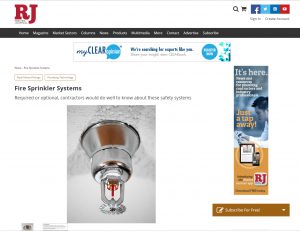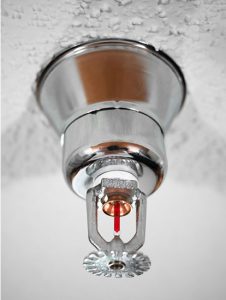 As seen on reevesjournal.com– May 12, 2016
As seen on reevesjournal.com– May 12, 2016
from Steven Baird
Required or optional, contractors would do well to know about these safety systems
Residential contractors working on newer homes may have seen a different, secondary plumbing system in some of them. Since the adoption of the 2010 California Building Standards Codes, fire sprinkler systems have been required additions to new residential construction in the Golden State. Requiring residential fire sprinkler systems is by no means just a Nanny-State, California thing. Maryland and the District of Columbia both have sprinkler requirements — Maryland by adopting the 2015 International Residential Code which requires fire sprinklers in new one- and two-family dwellings, and the District of Columbia by legislating fire sprinkler systems in new residential construction effective Jan. 1, 2011.
The rest of the west, though, have a somewhat more casual attitude, with either specific prohibitions or allowing local jurisdictions to adopt residential fire sprinkler requirements.[Check out the whole country’s residential fire sprinkler requirements by visiting the National Fire Protection Association’s “Sprinkler requirements by State” page at http://www.firesprinklerinitiative.org/legislation/sprinkler-requirements-by-state.aspx. —Ed.]
So, whether you’re in California or an area that allows local jurisdictions to adopt fire sprinkler requirements, you’re going to want to know a little about these systems. We spoke with Steven Baird, Armstrong Fluid technology’s global product marketing manager for fire products, about what contractors need to know.
Reeves Journal: What is your company’s most recent or most popular package? What does it do?
Steven Baird: We offer a FirePak which is a prepackaged system that includes fire pump, driver (motor or engine), fire pump controller, jockey pump, controller, with all code-required valves and fittings, and optional city bypass and/or flow meter loops. The main benefits are guaranteed code compliance, compact design, minimal on-site assembly space and time required.
RJ: There seems to be two basic segments to the fire safety arena: new construction and maintenance, correct?
SB: I’d say it’s more like three: new construction; maintenance /replacement for no longer functioning equipment; and, buildings that are being renovated and/or repurpos ed (i.e. an industrial or warehouse location that’s being repurposed for multi-residential).
ed (i.e. an industrial or warehouse location that’s being repurposed for multi-residential).
With those second and third groups it comes down to having to update equipment to current code requirements and possibly adding fire protection equipment to accommodate the new hazard type as defined by NFPA codes.
RJ: What is the guiding code on the new construction side?
SB: There will be state or municipal building codes to follow. Most of these will have adopted the National Fire Protection Association codes. But as the NFPA codes are updated regularly, most on a continuous three-year cycle, different states or municipalities will take different lengths of time to adopt the latest version of the codes for their jurisdiction.
RJ: Basically, how is a new system designed?
SB: Very basically it would go something like this:
- Determine the hazard level of the building;
- Determine the fire protection system layout (how many sprinkler heads, hose cabinets, stand pipes, etc.) where they are required to be located based on building design and hazard level;
- Then perform hydraulic design calculation to see what water flow and pressures are required;
- Check/test the available water flow and pressure from the building source;
- Based on the above if needed size and specify what type of fire pump system is needed;
- Determine what alarm requirements are for the building; and,
- Etc.
There are a million other steps but it really depends on what aspect of the fire safety system is being considered.
RJ: What training is available for those who may want to design these systems?
SB: There’s training on various parts of the fire system available through group like NFPA, the American Fire Sprinkler Association, the National Fire Sprinkler Association, some post-secondary institutions, and some of the certifying agencies.
RJ: Is certification available/required?
SB: There are a couple of nationally recognized fire protection certification organizations mentioned in NFPA 20 including the National Institute for Certification in Engineering Technologies and the International Municipal Signal Association, but the real key is to ensure whatever certification the designer has it is recognized by the Authority Having Jurisdiction – the local authority who determines if the system is acceptable.
RJ: On the maintenance side, how often does a commercial system need to be inspected/tested?
SB: Testing for the fire pump system is defined in NFPA 25. The 2014 edition requires a weekly run test (pressure test only, no flow) for diesel engine driven fire pumps, electric motor-driven fire pumps with limited service controllers, electric motor-driven fire pumps supplied from a water tank, and electric motor-driven fire pumps in a high rise building. For all other electric motor-driven fire pumps a monthly run test is required (again pressure test only, no flow). There is also a requirement for an annual test where you have to actually flow water as well either through a flow meter - or a hose header to prove the water source as well as the fire pump system.
RJ: Who does that? Is there a specialized field or is that accomplished by a building’s contracted plumbers, for example?
SB: In NFPA 25 section 3.3.34 it defines who’s qualified as “A competent and capable person or company that has met the requirements and training for a given field acceptable to the AHJ (Authority Having Jurisdiction – local authority who determines if the system is acceptable, often the fire marshal).
In reality it’s the building owner’s responsibility to ensure the complete fire system is designed, installed, and maintained properly.
Many sprinkler contractors offer this type of service and maintenance contract. I would say that a general plumbing contractor without experience on fire systems wouldn’t know enough about the relevant fire codes and the specific operation of the equipment to do this safely.
RJ: What are some common problems that turn up during inspections/tests?
SB: For the fire pump systems the most common issues occur during the initial start-up of the system and have to do with improper installation of the equipment. Things like:
- Not flushing out the supply lines to clear debris prior to installing the fire pump, this leads to items like rocks or tools going into the pump and damaging the impeller which means replacing the pump.
- Not installing the cooling lines to the engine correctly, this leads to an overheating engine.
- Incorrectly wiring the motor (i.e. switching the leads) which will cause the motor to turn the wrong direction and the pump won’t produce the required pressure.
- Improperly installing the sensing lines (water lines between the pump discharge and the fire pump controller)
- Not setting the correct start pressure on the controller
- Leaks in the pipe joints
For the sprinkler system I’ve heard of issues such as sprinkler heads that have been painted over (they must be replaced if this occurs) and changes to the layout of the building (moving or adding an internal wall that blocks a sprinkler head).
RJ: If certification is required to inspect/test systems, is that training/certification something a contractor could send an in-house technician to?
SB: Interestingly according to the code to be able to inspect or test a system you have to be a “Qualified Person” which is defined in NFPA 20, 2016 edition, section 3.3.46 as “A person who, by possession of a recognized degree, certificate, professional standing, or skill, and who, by knowledge, training, and experience, has demonstrated the ability to deal with problems related to the subject matter, the work, or the project.” This is a very loose definition but it’s all that’s required by the code.
There are more detailed requirements in NFPA 20 for anyone who will design, install, or service a fire pump system. Directly from NFPA 20, 2016 edition:
RJ: Have there been any new regulatory developments on the commercial fire sprinkler front we ought to know about? What is it and what’s it require?
SB: NFPA this year released new editions of NPFA 20 (fire pumps), NFPA 13 (sprinklers), and NFPA 14 (stand pipes) all of which have some changes. In the NFPA handbooks for each of these they do list out the more significant changes for each.



